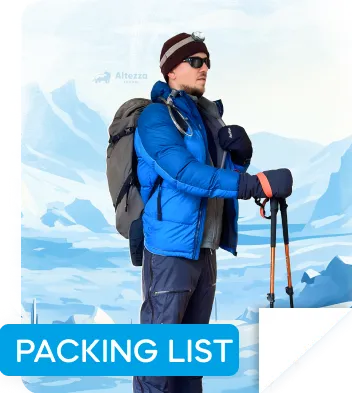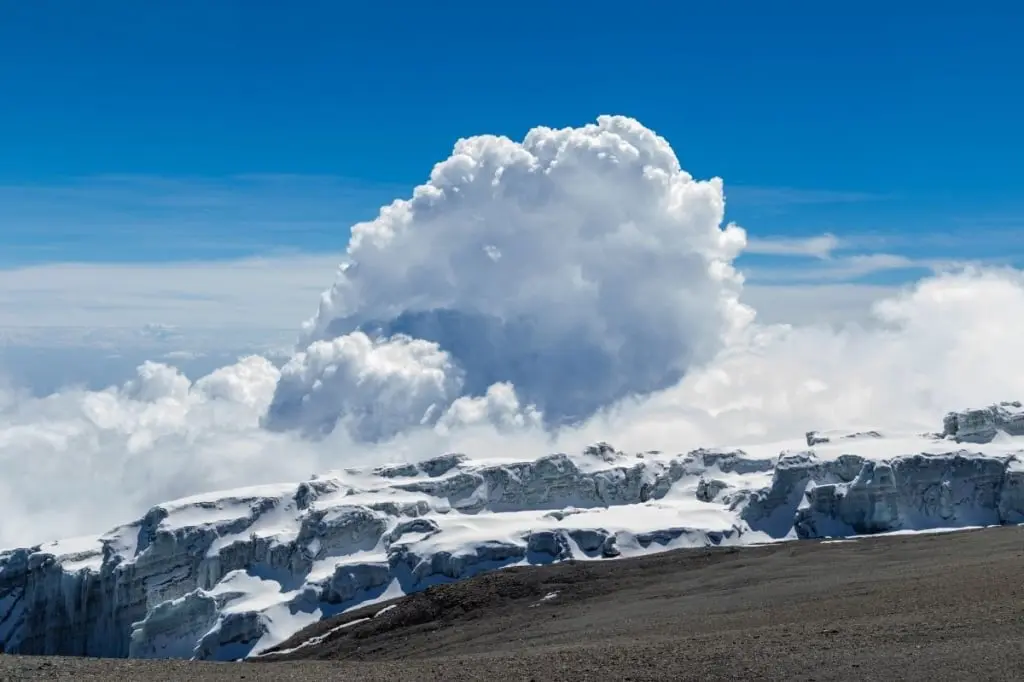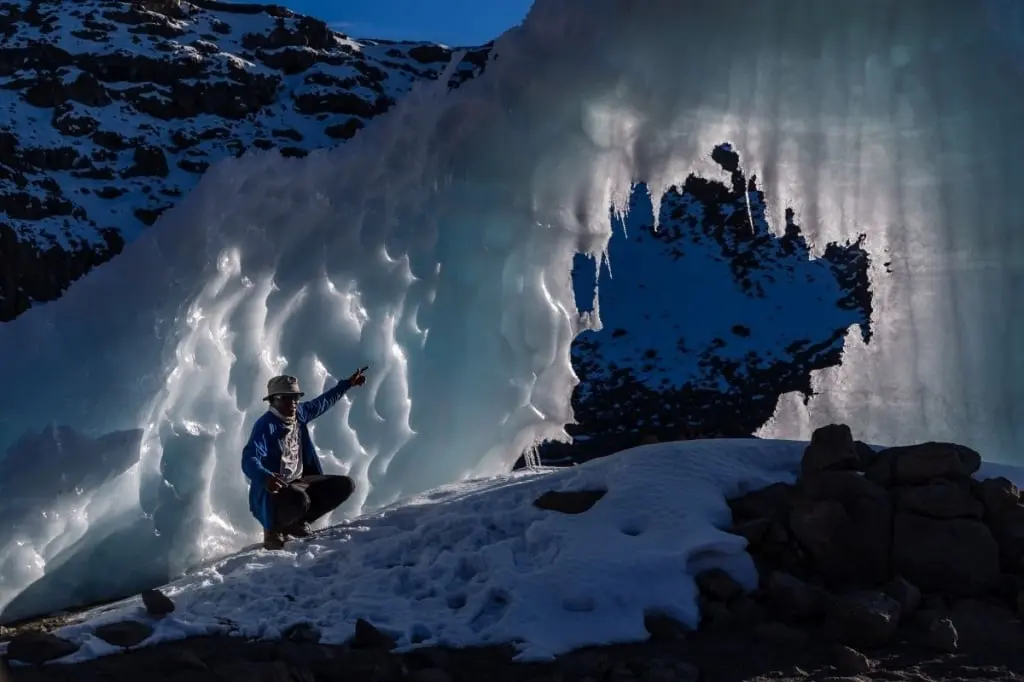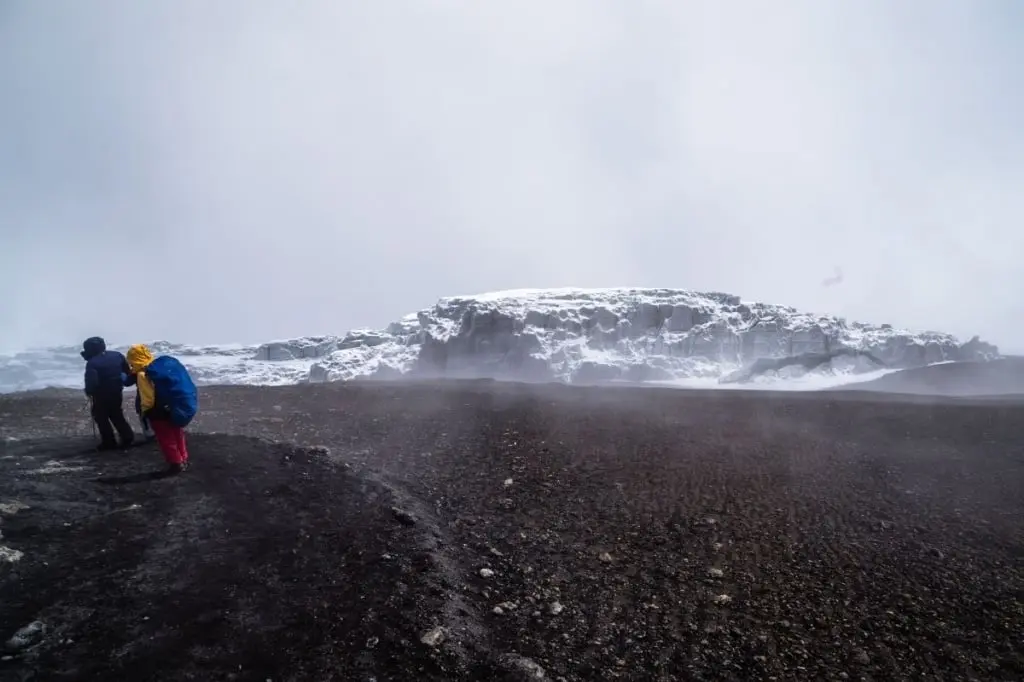Glaciers of Kilimanjaro - Fragile Beauty
Glaciers are masses of ice found either at the poles of the earth or atop mountains. There are also tropical glaciers; ice formations found at high altitudes on mountains along the earth’s equator. In Africa, there are only three places to find tropical glaciers: Mount Rwenzori in Uganda, Mount Kenya in Kenya, and the largest and most numerous, on Mount Kilimanjaro in Tanzania.
Unfortunately, glaciers around the world are disappearing due to climate change. The terrible truth is, Kilimanjaro’s glaciers are quickly melting due to changes in weather conditions such as humidity and warmer air. Time is running out to see Kilimanjaro’s largest glacier, Furtwängler Glacier, first-hand.
Key facts
Estimated age of glaciers: 11,700 years old.
Based on studies in Kilimanjaro’s Northern Ice Field, the age of the glaciers is probably 11,700 years old. However, some areas that are vulnerable to weather and sunlight and have probably experienced melting and refreezing were estimated to be 800 years old.
Furtwangler Glacier has been shrinking rapidly:
size in 1976: 113,000 square metres (1,220,000 sq ft)
size in 2000: 11,000 square metres (120,000 sq ft)
Mapping of Kilimanjaro’s ice cover has been recorded since the early 1900s. It has been determined that since 1912, more than 80% of the ice cover atop all of Kilimanjaro has already disappeared. An estimated 85% of Furtwangler Glacier, specifically, melted by the year 2011.
Rapid climate change from the 20th century is directly responsible for the increased rate of loss or sublimation, of Kilimanjaro’s glaciers.
Estimated date of complete loss of glaciers on Kilimanjaro: between 2030 and 2060
Mount Kilimanjaro’s peak reaches an astounding 5,895 meters. Climbers who successfully reach the summit will have a view of Kilimanjaro’s glaciers and icefields. The northern and southern icefields provide protection for the base of some of these glaciers. Unfortunately, as snow has been increasingly disappearing on Kilimanjaro over the years, the icefields have become more and more exposed, resulting in increased melting of the glaciers and icefields over the years.
Photos of the glaciers and icefields from even 10 years ago provides startling evidence of the rapid loss of ice. We encourage climbers to take photos and share them so that Altezza Travel can do our part in helping tell the world about the effects of climate change on Africa’s highest mountain.
Some of the most notable tropical glaciers atop Kilimanjaro include:
Furtwängler Glacier
- Kilimanjaro’s Largest Glacier
- Estimated extinction: 2030
- Named for Walter Furtwängler, one of the climbers to successfully summit Kilimanjaro in 1912
Rebmann Glacier
- Located near the Southern Icefield
- Named for Johann Rebmann, a German missionary-explorer who was the first European to make a record of glaciers on Kilimanjaro in the year 1848
Credner Glacier
- Located near the Northern Icefield
- One of the largest remaining glaciers on Kilimanjaro, to-date, but is rapidly disappearing. Studies conducted in association with the Smithsonian Institute have estimated extinction before the year 2030
Arrow Glacier
- Arrow Glacier is the renamed remnant of the former ‘Little Barranco Glacier’ found along Kilimanjaro’s Lemosho Route
- This small surviving piece of glacier is quickly melting and may have even vanished by the publication of this article. This is the sad, irreparable reality of global warming. Once a glacier has completely disappeared, there is no way to recover it
Disappearing of glaciers from Kilimanjaro
According to National Geographic, the glaciers of Mount Kilimanjaro may disappear as soon as the year 2030. Some more optimistic scientists project the date of extinction for the Furtwängler Glacier to be 2060; however both dates are still well within many readers’ lifetimes.
Devastatingly, the destruction of the Furtwängler Glacier and other tropical glaciers on Kilimanjaro are too advanced to be slowed or reversed in any way. The impact of global warming in regions such as Tanzania and important locations, such as the largest mountain in Africa cannot be underestimated.
Tracking
Based on mapping of the ice fields and recorded observations from the peak of Kilimanjaro in the early 1900’s, compared to the current data, it is clear that the glaciers are swiftly disappearing.
Of course, the ice may have receded somewhat over the centuries, but the rate of lost ice has been measurably sped-up in the past few decades: studies from the National Academy of Sciences reveal that the ice cover atop Kilimanjaro decreased at a rate of approximately 1% from the years 1912 until 1953. However, from 1989 until 2007, the rate of decrease more than doubled to a startling 2.5%. An alarming increase that must be attributed to the effects of climate change, which have been more pronounced in the last few decades.
According to NASA, from their official Earth Observatory page, where experts can view satellite imaging for various locations around the globe, including overtop Mount Kilimanjaro: “Between 1912 and 2011, the mass of ice on the summit decreased by more than 85 percent.
It’s no longer a question of whether the ice will disappear but when
NASA Earth Observatory
Another aerial study atop Kilimanjaro concluded that “All ice bodies on Kilimanjaro have retreated drastically between 1912–2003.” As this data is over a decade old, we can conclude that the ice fields and tropical glaciers of Kilimanjaro have reduced by over 90%.
Main reasons
Tropical glaciers, such as Furtwängler Glacier are an anomaly. The high elevation of mountain-top glaciers explains the presence of snow and ice, but the strong sun of the equator and relatively consistent tropical weather mean that tropical glaciers are vulnerable to the elements of nature.
However, icefields and snow had protected the glaciers atop Mount Kilimanjaro for over 10,000 years. It is only in the past few decades that we have noted a drastic loss of the icefields and disappearance of some glaciers entirely.
While we talk of glaciers ‘melting’ that actual process of ice loss on Kilimanjaro is more likely sublimation: a process wherein ice does not melt slowly into water, instead it evaporates to a vapor. Hence, the ice on Kilimanjaro becomes a cloud and sends perspiration on another area at a later time. This effectively means the opportunity of water freezing back into snow or ice and saving Kilimanjaro’s glaciers, or slowing the disappearance, is not possible.
Looking at the increased rate of ice loss in recent decades, it is undeniable that climate change is the culprit for the disappearance of Kilimanjaro’s glaciers.
The Future
Unfortunately, no way has been determined to slow the disappearance of icefields or glaciers atop Kilimanjaro. It is our hope that this will not have a significant negative effect on tourism in Tanzania, as many local guides depend on regular tourism for their income.
However, we at Altezza Travel hope that this reality spurs more tour operators and larger corporations to take necessary steps to preserve the natural beauty of Tanzania. While some moves have been made to ensure conservation areas keep animals safe, help protect the endangered elephant and rhinoceros populations in Tanzania, we must encourage more to be done to protect this precious environment.
Tourists who wish to experience the beauty of Africa, view endangered animals and physically visit some of the most remarkable places in the world (such as UNESCO Heritage Sites; Serengeti and Ngorongoro Crater) should ensure they book with socially-responsible operators who have taken steps to reduce any negative impact on Tanzania’s environment. This includes operators leading Kilimanjaro treks; Africa’s highest mountain is already losing it’s important icecover and glaciers, we do not want it to lose anything else in the future.
At Altezza Travel we ensure our mountain guides are not only trained and aware about precautions and protecting nature, but they are just as passionate about preserving Tanzania’s environment as we are. Our guides love Tanzania, either as their native home or as a new-found love. They take great care to ensure that Altezza’s mountain treks are eco-friendly with extra effort put in to how we camp and precautions we take to ‘leave no trace’ and operate in a sustainable, responsible way.
If you want to learn more, please check out Altezza Travel’s socially-responsible projects, as well as our animal rescue center (which saves orphaned elephants to return to the wild).
Ice and climbers
While ice climbing is an incredible sport, out of respect for Africa’s diminishing tropical glaciers we do not promote ice climbing on any of Mount Kilimanjaro’s glaciers.
Recently, professional ice climber Will Gadd returned to Tanzania to climb the mountain’s famous Furtwängler Glacier. Gadd successfully ice climbed Kilimanjaro’s largest glacier back in 2014, but when he arrived in 2020, the same glacier was noticeably smaller and the ice walls had become dangerously thin. Gadd abandoned his climb and instead, channelled his passion for the sport into becoming an advocate for climate change with the United Nations.
Instead of ice-climbing Kilimanjaro’s glaciers, we encourage visitors to trek Mount Kilimanjaro and see the disappearing glaciers first-hand before they melt away completely. Climbing teams can take photos of these soon-to-be-extinct aspects of nature with an environmentally-friendly Altezza Kilimanjaro climb.
During your trek you can walk on or stand beside some of the surviving glaciers found on Kilimanjaro. This activity should not increase the melting of the glacier if you are careful and do not intentionally cut at or chip away any part of the ice.
Conclusion
The loss of Kilimanjaro’s glaciers is a sad, but irreparable truth. These ice formations which stood for an estimated 11,700 years have not decreased due to climate change.
We cannot stop the process of disappearance of these tropical glaciers, but we can learn a lesson from this situation: to care for our planet and choose sustainable, responsible approaches.
We want guests to experience Africa’s highest mountain, largest National Parks and unrivaled natural beauty found in Tanzania. We encourage those who can to trek Kilimanjaro before the icefields and glaciers have vanished, and share our story with others. May the message about the importance of preserving the environment be shared: the best way to do so is from personal experience, once you have fallen in love with Tanzania yourself.

All content on Altezza Travel is created with expert insights and thorough research, in line with our Editorial Policy.
Want to know more about Tanzania adventures?
Get in touch with our team! We've explored all the top destinations across Tanzania. Our Kilimanjaro-based adventure consultants are ready to share tips and help you plan your unforgettable journey.




















